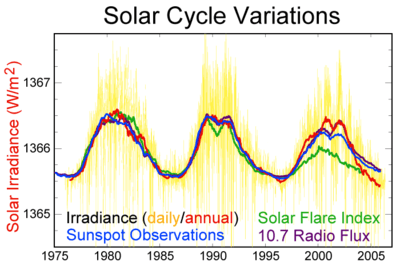Solar cycle 13
| Solar cycle 13 | |
|---|---|
 The solar corona during an eclipse in solar cycle 13 (1893). | |
| Sunspot data | |
| Start date | March 1890 |
| End date | January 1902 |
| Duration (years) | 11.8 |
| Max count | 146.5 |
| Max count month | January 1894 |
| Min count | 8.3 |
| Spotless days | 934 |
| Cycle chronology | |
| Previous cycle | Solar cycle 12 (1878-1890) |
| Next cycle | Solar cycle 14 (1902-1913) |

Solar prominences during an eclipse in solar cycle 13 (28 May 1900).
Solar cycle 13 was the thirteenth solar cycle since 1755, when extensive recording of solar sunspot activity began.[1][2] The solar cycle lasted 11.8 years, beginning in March 1890 and ending in January 1902. The maximum smoothed sunspot number (SIDC formula) observed during the solar cycle was 146.5 (January 1894), and the starting minimum was 8.3.[3] During the minimum transit from solar cycle 13 to 14, there were a total of 934 days with no sunspots.[4][5][6]
There were a number of intense solar proton events during solar cycle 13,[7] as well as geomagnetic storms such as e.g. in September 1898 which affected telegraph lines.[8]
See also
References
- ↑ Kane, R.P. (2002). "Some Implications Using the Group Sunspot Number Reconstruction". Solar Physics 205(2), 383-401.
- ↑ "The Sun: Did You Say the Sun Has Spots?". Space Today Online. Retrieved 12 August 2010.
- ↑ SIDC Monthly Smoothed Sunspot Number. ""
- ↑ Spotless Days. ""
- ↑ What's Wrong with the Sun? (Nothing) more information: Spotless Days. ""Archived copy". Archived from the original on 14 July 2008. Retrieved 12 July 2017. "
- ↑ Solaemon's Spotless Days Page. ""
- ↑ Peristykh, A. N.; Damon, P. E. (17–25 August 1999). Multiple Evidence of Intense Solar Proton Events During Solar Cycle 13. Proceedings of the 26th International Cosmic Ray Conference. pp. 264–267.
- ↑ http://www.solarstorms.org/SRefStorms.html
This article is issued from
Wikipedia.
The text is licensed under Creative Commons - Attribution - Sharealike.
Additional terms may apply for the media files.
